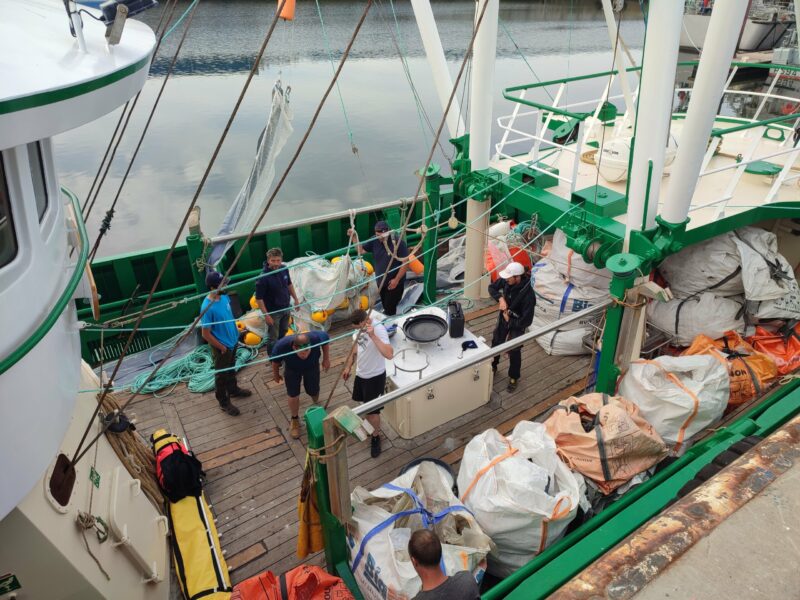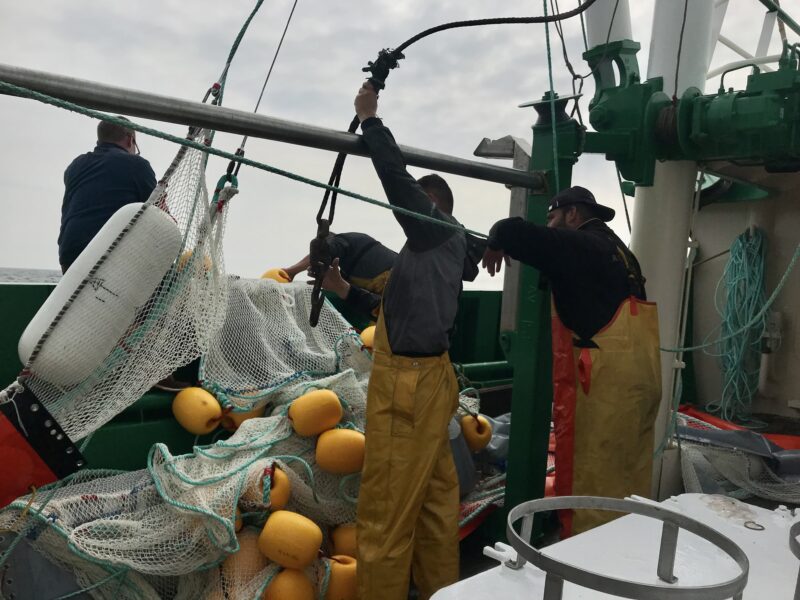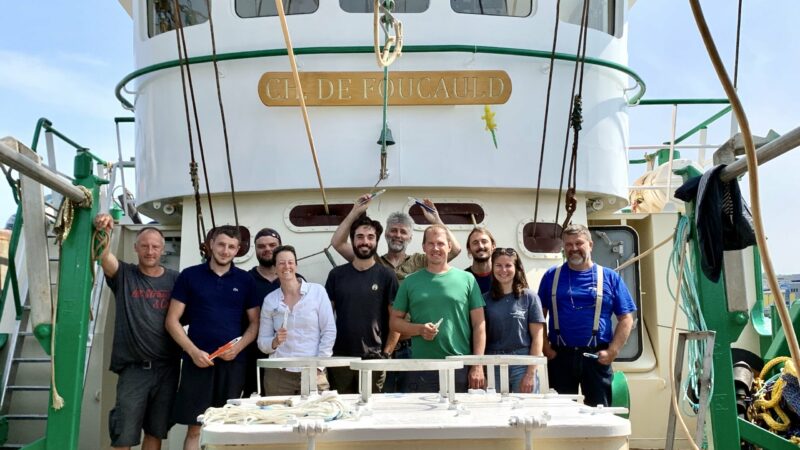Successful new sea trials for Manta’s surface collection systems for floating waste
Manta Project
Plastic pollution
17 July 2023
At the end of 2022, teams from MANTA INNOVATION, The SeaCleaners' integrated engineering office, spent three intense days aboard the vessel Charles de Foucauld in Boulogne-sur-Mer to carry out the very first full-scale tests of the surface collection net systems that will equip the MANTA. Now, in June 2023, the 2nd series of tests is underway: the nets have been validated and are ready for integration!

A key step in the development of the MANTA, successfully completed by our crew The SeaCleaners!
Surface collection systems play a central role in the floating macro-waste collection mission of the future ambassador boat for marine pollution control. This is why it is vital to develop all aspects of these systems, so that they meet the challenges of efficiency in terms of capturing and retaining waste, while minimizing the MANTA‘s drag and energy consumption.
The first tests were part of this approach, and we told you about future tests to be carried out with this same objective in mind… And now it’s done! We tell you all about it.
The objectives of this 2nd series of tests:
- Test the pre-production prototype of the surface collection systems (near-final version) to verify its behavior at sea after the modifications made.
- Evaluate the equipment supplied by different suppliers in order to select the best supplier for the production version.
- Verify the collection efficiency of full-size Manta nets, as well as of a marketable net for the Kit de Collecte project.
- Test different mesh and pocket size configurations, with the aim of achieving a minimum waste size of 2.5 cm.
- Measure the maximum drag generated under real sea conditions at different speeds, and define the impact of parameter variations (mesh sizes, lengths, etc.) on drag.
- Confirm predictive studies of outrigger dimensions.


Advances :
During the first trials, certain technologies were tested and approved, but also criticized by our experts… It is this iterative process that enables us to constantly optimize future Manta equipment. Among the challenges we had to overcome:
- We had encountered some problems with the metal solution (ASTM) attachment systems, which proved too heavy and difficult to handle, leading to tears in the net.
- As far as the net itself was concerned, a number of factors drew our attention: some waste remained trapped in the mesh, while others overflowed from the pocket. The mesh was too large for the waste we wanted to collect. We aim for a smoother surface to prevent waste from jamming inside.
- What’s more, the bag adopted a “mushroom” shape in the water, which didn’t favor the collection surface. Some waste got stuck at the entrance to the pocket due to a problem with wing tension, and the bottom of the net tended to sink, resulting in increased drag resistance.
With these points of concern in mind, modifications were made to the surface collection systems. The new tests studied the behavior of the systems following these changes.
- The meshes were tightened on the pocket and wings to prevent problems with waste catching, and to enable smaller items to be collected while remaining below the acceptable drag threshold.
- The length of the wings has been increased to exactly match the Manta configuration.
- Various manufacturers were tested to select the most suitable for the transition to series production.
- The attachment systems were lightened and replaced by simple ramendages (seams) and adjusted to ensure better dynamic handling.
- The wings have been optimized to improve buoyancy and reduce overall weight and drag. The foam bladders have been replaced by 100% inflatable elements, less cumbersome to store and lighter.
- The bag is kept curved by loops to maintain a streamlined shape for collection and avoid submersion.
The result?
“We're already imagining ourselves in the back of the Manta!”
All smiles at the back of the boat, The SeaCleaners and Manta Innovation teams are moved… The towed collection system has been validated! This daring project is taking shape, and we are gradually seeing its component parts being built. It’s wonderful to see, and motivates us all the more.
Key figures? Comparison 2022 vs 2023 : The results speak for themselves!
- We have significantly reduced the mesh size, dividing it by 3, enabling us to collect fragments down to 2.5 cm.
- Thanks to our 100% full bag, we have more than doubled the volume of waste collected, from 4.5 m3 to 5 m3 last year in 2022 to an impressive 9 m3 to 10 m3.
- +60% in the mass of wet dewatered waste collected, from 750 kg in 2022 to 1.2 tonnes in 2023, demonstrating our growing collection efficiency.
- Although drag has increased by 32% compared with 2022, we have ensured that it remains within acceptable values for collection. In addition, we have extended our wings by 13% to increase the collection area, while using a pocket 100% filled with clogging waste (such as clothing, tarpaulins, etc.).
- Thanks to our transition to 100% inflatable systems, and by removing metal solutions (ASTM), we were able to lighten the weight of the wings by 90 kg, which we reinvested in smaller meshes, guaranteeing even more efficient collection.
- The total weight of the system remained similar to that of 2022 (around 300 kg), but with increased operability and better use of storage space thanks to our inflatable systems and smaller meshes.
- All in all, we managed to achieve a 30-40% gain in the volume occupied by our system, and a fine optimization of space.
These impressive figures testify to our teams’ constant commitment to improving our performance and taking the fight against marine pollution to new heights!

Thanks
- I’d like to start by thanking Captain Luc Ramet and the entire crew (Mathieu, Cédric, Luc and Sébastien) of the Charles de Foucauld. They even proudly flew The SeaCleaners flag on their boat at the Fête de la mer in Boulogne.
- Many thanks to VALORPLAST, who supplied the big bags of waste and ensured their delivery and collection.
- DECATHLON Hendaye’s Water Sports design office, which supplied the drop-stitches at cost price.
- The Coopérative Maritime de Lorient, who provided invaluable advice, the loan of load cells, and for their proactive response to the manufacturing process.
- The Coopérative Maritime Etaploise, which provided support for the manufacture of spare equipment, and lent a Fenwick and personnel to move the big bags.
- The AFFMAR, which provided navigation authorization thanks to Mme Célia Garnier and M. Philippe Ducrocq, head of the Littoral Unit of the Pas-de-Calais Maritime Affairs.
- Our equipment manufacturers for their efficiency in producing the equipment on time, despite a tight schedule.
- The Brittany Region, which financed the initial trials.
- The entire ZEvent community for their support in financing this year’s trials.
- Finally, a huge thank you to our crack team The SeaCleaners and Manta Innovation, of course!





























